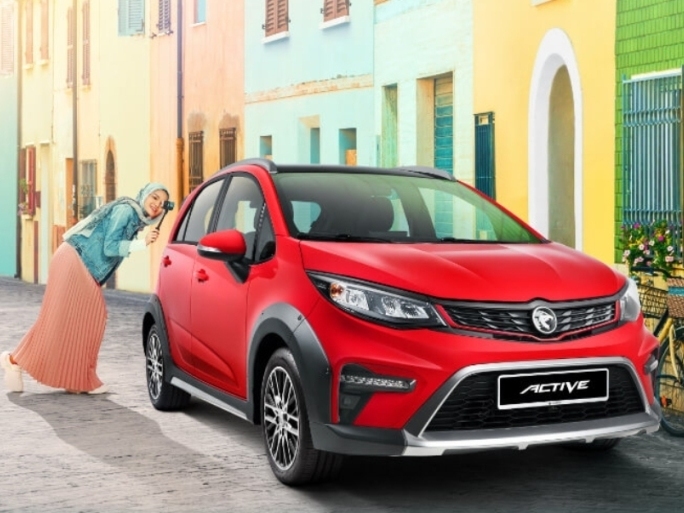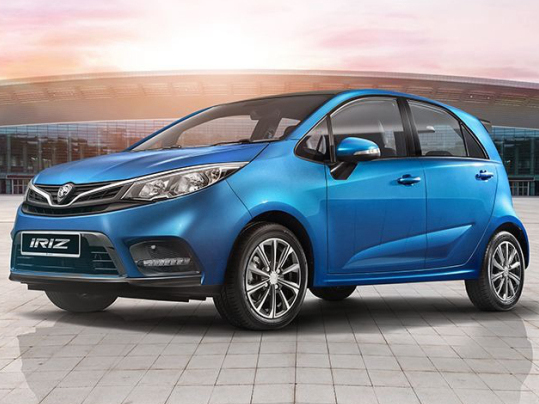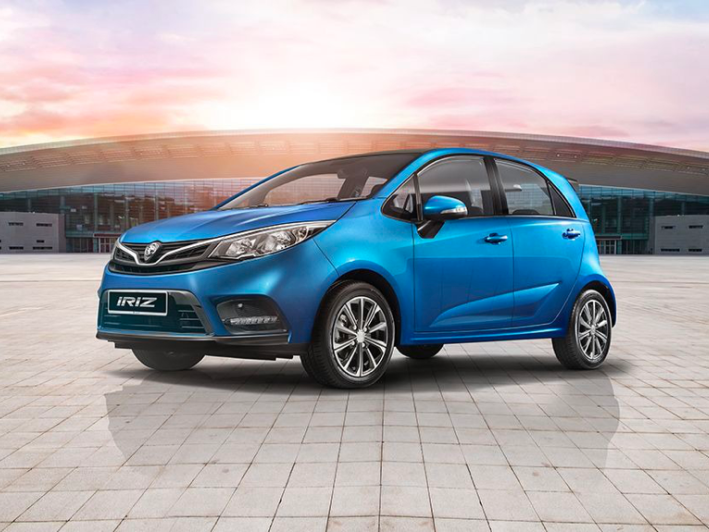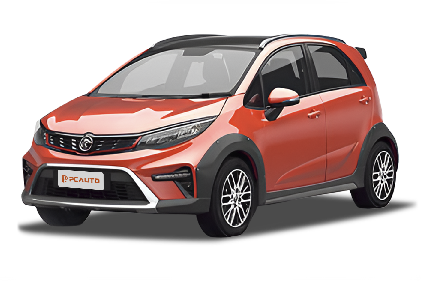Q
How about the fuel economy of Iriz?
The fuel economy of the Iriz varies depending on the model and usage conditions. The official combined fuel consumption of the 2023 Proton Iriz 1.3 Standard CVT is 6.9 L/100 km. The official combined fuel consumption of both the 2023 Proton Iriz 1.6 Executive CVT and the 2023 Proton Iriz 1.6 Active CVT is 7.4 L/100 km. Overall, these figures are at a medium level among vehicles in the same class, making it relatively fuel-efficient. However, the actual fuel consumption may fluctuate due to factors such as driving habits, road conditions, and vehicle load. Maintaining good driving habits such as driving smoothly, controlling the speed reasonably, and avoiding sudden acceleration and braking, as well as regularly maintaining the vehicle, can help improve the fuel economy of the Iriz and bring its fuel consumption closer to the official data.
Special Disclaimer: This content is published by users and does not represent the views or position of PCauto.
Related Q&A
Q
What is the fuel consumption of 2021 Proton Iriz?
The fuel efficiency of the 2021 Proton Iriz varies by engine configuration. Models equipped with the 1.3-liter VVT engine deliver an average combined fuel consumption of around 5.6 liters per 100 kilometers, while the 1.6-liter VVT version comes in at approximately 5.8 liters per 100 kilometers. Actual fuel usage may fluctuate slightly depending on driving habits, road conditions, and vehicle maintenance status. This car features Proton's Efficient Dynamics technology, including lightweight body design and low-rolling-resistance tires, which help improve fuel economy. For Malaysian consumers, the Iriz's fuel efficiency ranks above average among its class of hatchbacks, making it suitable for city commuting. To further reduce fuel consumption, it's advisable to maintain a steady speed, avoid sudden acceleration and hard braking, and regularly replace the air filter and spark plugs. It's worth noting that fuel efficiency test data is typically based on ideal laboratory conditions, and real-world driving may vary due to factors like weather and traffic conditions. Therefore, owners can track their actual fuel consumption under personal driving conditions by recording fuel refills and mileage driven.
Q
What is the fuel consumption per 100km of Proton Iriz?
The official combined fuel consumption figures for different versions of the Proton Iriz show some variation. The 1.3-liter version has an official combined fuel consumption of 6.6 to 6.9 L/100km, while the 1.6-liter version ranges from 7.4 to 8.36 L/100km. However, the actual fuel consumption of a vehicle may fluctuate due to factors such as driving habits, road conditions, and vehicle load.
For instance, aggressive acceleration, hard braking, and frequent stop-and-go driving can lead to increased fuel consumption. Additionally, driving for extended periods in congested conditions, where the engine is idling or operating at low speeds, can also cause fuel efficiency to drop. Excessive vehicle load, such as carrying numerous items or a full passenger capacity, similarly results in greater fuel usage.
Understanding these influencing factors can help drivers maintain good driving habits and manage vehicle load effectively, thereby reducing actual fuel consumption.
Q
What are the fuel consumptions of Iriz and Persona?
The fuel consumptions of Proton Iriz and Persona primarily depend on engine configuration and driving conditions, though official test data provides general reference ranges.
The Iriz is equipped with 1.3L and 1.6L VVT naturally aspirated engines. The 1.3L manual variant achieves approximately 14 km/L (city) to 18 km/L (highway) under standard test conditions, with the automatic version being 1-2 km/L lower. The 1.6L version consumes about 10% more fuel.
The Persona is equipped with a 1.6L engine, delivering combined fuel economy of about 15-16 km/L for manual transmission and 14-15 km/L for CVT variants. Its heavier body results in slightly lower fuel efficiency compared to the Iriz.
In real-world driving, fuel consumption may worsen by 20% in heavy traffic conditions, while steady-speed cruising on highways like the North-South Expressway may approach official figures.
Owners are advised to maintain proper tire pressure (190-210 kPa), avoid aggressive acceleration, and utilize cruise control to optimize fuel economy. These models deliver average fuel efficiency for their class in Malaysia, with regular maintenance (including throttle body cleaning and spark plug replacement) being crucial for sustaining optimal performance.
Q
What is the fuel consumption of Iriz 2018?
The fuel consumption of the 2018 Proton Iriz varies depending on engine and transmission configurations. The 1.3L manual version has a combined fuel economy of approximately 5.5L/100km (about 18.2km/L), while the 1.3L CVT automatic version averages around 5.9L/100km (about 17km/L). As for the 1.6L engine variants, the manual transmission model consumes about 6.1L/100km (approximately 16.4km/L), with the CVT automatic version at roughly 6.5L/100km (about 15.4km/L).
Actual driving fuel efficiency is influenced by multiple factors, including traffic conditions (such as higher consumption in congested Kuala Lumpur urban areas), driving habits (aggressive acceleration or high-speed driving increases fuel usage), and vehicle maintenance condition (cleanliness of air filters and spark plugs, proper tire pressure).
To optimize fuel economy, we recommend maintaining smooth throttle control, utilizing Eco mode (if equipped), and performing regular maintenance. Proper driving techniques can help your Iriz achieve closer-to-official fuel consumption figures while also extending its engine lifespan.
Q
What's the color of Proton Iriz?
The Proton Iriz offers a variety of color options in Malaysia, including standard colors such as Snow White, Silver, Graphite Grey, Ruby Red, and Marine Blue. Some variants even have the combination of two colors, like Solid Black paired with Pearl White. All paints utilize high-quality coatings designed for Malaysia's hot and humid climate, ensuring long-term color retention without fading.
When selecting a color, buyers may consider not only personal preference but also factors like resale value and maintenance costs. Lighter colors such as white and silver are popular choices in Malaysia as they absorb less heat during summer months and show minor scratches less noticeably. Meanwhile, darker colors like black or red offer a more dynamic appearance but are more sensitive to sun exposure and dust.
Q
Is Iriz equipped with a turbocharged engine?
The Proton Iriz is not available with a turbocharged engine option, as the entire lineup is equipped with naturally aspirated engines with either 1.3L or 1.6L displacement. While the Iriz lacks turbocharging technology, its engines perform well in fuel efficiency and daily urban driving. The linear power output of these naturally aspirated engines is particularly suitable for Malaysia's frequent stop-and-go traffic conditions.
For consumers seeking more powerful performance, Proton offers other models like the X50 or X70, both equipped with 1.5L turbocharged engines that provide stronger acceleration. Proton has not announced any plans to introduce a turbocharged version of the Iriz, but any future developments would typically be released through official channels.
For budget-conscious owners prioritizing practicality, the naturally aspirated Iriz is an attractive choice, offering advantages in maintenance costs and fuel efficiency.
Q
What are the different variants of Iriz?
The Proton Iriz is available in multiple variants. In engine displacement, there are 1.3L and 1.6L options.
The 2023 Proton Iriz 1.3 Standard CVT is priced at RM 42,800 with an official combined fuel consumption of 6.9L/100km and a maximum engine output of 95PS.
The 2023 lineup also includes two 1.6L versions: the 1.6 Executive CVT and 1.6 Active CVT, priced at RM 50,300 and RM 57,300 respectively. Both are equipped with a 109PS engine with official combined fuel economy of 7.4L/100km.
These variants differ in configurations. For example, the 1.3 Standard CVT provides 4 airbags, while both 1.6L versions offer 6 airbags. Additional features are also different - the 1.6 Active CVT includes voice-controlled air conditioning, while some models are equipped with front parking sensors and reverse cameras. Buyers can choose according to their budget and requirements.
Q
What is the safety rating of Proton Iriz?
The Proton Iriz achieved an impressive 5-star safety rating in the 2014 ASEAN New Car Assessment Program (ASEAN NCAP) testing - a remarkable accomplishment for a B-segment hatchback. This rating shows the Iriz's high standards in body structure rigidity, crash protection, and active/passive safety features. The model is equipped with key safety technologies including dual airbags (upgraded to six airbags in higher trims), ABS anti-lock braking system, EBD electronic brake-force distribution, and ESC electronic stability control.
Notably, the Iriz scored 14.93 out of 16 points in adult occupant protection and 42.45 out of 49 points in child occupant protection - outstanding results in its vehicle class that make it particularly suitable for safety-conscious consumers in Malaysia. While the 2023 model hasn't undergone renewed testing, subsequent Proton models like the X50 and X70 have maintained these high safety standards, proving the brand's persistent commitment to safety performance.
For budget-minded consumers in Malaysia seeking premium safety features, the Iriz is a popular choice.
Q
What type of engine is the Proton Iriz equipped with?
The Proton Iriz mainly adopts naturally aspirated engines, available in 1.3L and 1.6L displacements.
The 1.3L engine has a displacement of 1,332 mL, delivering maximum power of 95 PS (70 kW) at 5,750 rpm and peak torque of 120 N·m at 4,000 rpm, with an inline 4-cylinder configuration.
The 1.6L engine features 1,597 mL displacement, producing 109 PS (80 kW) maximum power at 5,750 rpm and 150 N·m peak torque at 4,000 rpm, also in an inline 4-cylinder arrangement.
These two engine options cater to different driver needs - the smaller displacement suits economical daily driving, while the larger engine provides enhanced performance for power-oriented drivers.
Q
What is the fuel consumption of the Iriz 1.3 manual transmission?
The Iriz 1.3 manual transmission model, officially named the 2019 Proton Iriz 1.3 VVT Standard MT, has an official combined fuel consumption of 6.7L/100km. This B-segment vehicle measures 3,945mm in length, 1,722mm in width, and 1,554mm in height, with a wheelbase of 2,555mm and a curb weight of 1,132kg. It is equipped with a naturally aspirated 4-cylinder engine delivering maximum power of 95PS (70kW).
Its front suspension features MacPherson struts, complemented by ventilated disc brakes. It runs on 175/65 R14 tires all around. Safety features include ABS anti-lock braking and electronic stability control. The cabin offers mostly manual-adjustment seats and a single-zone manual air conditioning system. Understanding these specifications will help you better know this model's fuel efficiency and overall performance.
Latest Q&A
Q
Does the BMW X3 2020 have CarPlay?
The 2020 BMW X3 does come with Apple CarPlay functionality. Back then, this feature was either a standard offering or an optional extra, depending on the specific trim level and equipment package of the vehicle. Drivers can seamlessly connect their iPhones through the iDrive system on the central display, accessing common apps like navigation, music, and calls. The interface is intuitive and supports Siri voice control, which really boosts convenience and safety behind the wheel. It's worth noting that CarPlay initially required a wired connection via the USB port, though some later software updates might have enabled wireless connectivity. To be sure, it's best to check your specific vehicle's configuration using the VIN or consulting local dealers. As for the infotainment system, both BMW's iDrive 6.0 and 7.0 versions offer solid compatibility. If you run into connection issues, try updating your phone's OS or the car's software. Android users can also connect their devices using Android Auto, which offers similar functionality, though there are some differences in app ecosystem support to keep in mind. For those looking to enhance their experience even further, exploring BMW's optional extras like enhanced Bluetooth and wireless charging is a good idea. These features complement CarPlay nicely – wireless charging, for example, eliminates the battery anxiety that can come with prolonged wired connections.
Q
Does the BMW X3 2020 have remote start?
The 2020 BMW X3 offers remote start functionality on select trims, though it requires the vehicle to be equipped with ConnectedDrive services along with the appropriate key or mobile app, like the BMW Connected App. This feature lets owners fire up the engine and adjust the cabin temperature via their smartphone beforehand—super handy for pre-warming or cooling the interior during extreme hot or cold weather. If your X3 didn’t come with it factory-installed, you can usually have the relevant module added later through an authorized BMW dealer, but make sure to check compatibility and warranty terms first. Remote start tech has become pretty common these days; beyond BMW, plenty of other brands offer similar features, though the specifics can vary—some might require a subscription or depend on certain network coverage. It’s a good idea to check your owner’s manual or hit up your dealer to confirm your exact setup, and also be aware of local laws regarding engine idling time to stay compliant. These kinds of tech features definitely boost convenience, but it’s still important to get familiar with how they work and any important dos and don’ts.
Q
Is there a recall on the BMW 3 Series 2020?
Regarding whether there's a recall for the 2020 BMW 3 Series, according to official records, this model has been subject to recalls worldwide due to potential issues with certain components, such as the fuel pump module or software system updates. However, the specific recall scope needs to be confirmed by checking the Vehicle Identification Number (VIN) on BMW's official website or at an authorized service center. It's advisable for owners to regularly pay attention to official notifications or directly contact local dealerships for the latest information to ensure the vehicle's safety performance meets standards. Additionally, regardless of whether a recall is involved, regular maintenance and inspections are crucial for maintaining the vehicle's condition, especially for electronic systems and key components. BMW's intelligent diagnostic tools can detect potential issues in advance. If any abnormalities are noticed, such as warning lights on the dashboard or unusual noises while driving, they should be addressed promptly to prevent minor problems from developing into safety hazards. For used car buyers, it's recommended to verify maintenance and recall records through official channels before purchasing to ensure transparency in the vehicle's history.
Q
Does the 2020 BMW X3 have a touch screen?
The 2020 BMW X3 does come with a touchscreen. It's equipped with BMW's latest iDrive 7.0 system, featuring a 10.25-inch center display that supports touch operation while still retaining the traditional rotary knob control, making it easy for drivers to operate quickly on the move. Beyond touch functionality, this screen also supports voice control and gesture commands, offering a more intelligent interactive experience. In the local market, the car's configuration is largely consistent with global versions. Owners can directly access navigation, entertainment, vehicle settings, and other functions through the screen, and the system also supports wireless Apple CarPlay, further enhancing convenience. It's worth noting that the iDrive 7.0 system has an intuitive interface design and fast response times, so even users new to BMW models can get the hang of it quickly. If you have high demands for in-car technology, the 2020 X3's system should meet your daily needs, and its hardware and software performance are also among the leading in its class.
Q
What generation is the 2020 BMW X3?
The 2020 BMW X3 belongs to the third generation (chassis code G01), which first launched in 2017 and got a mid-cycle refresh in 2020, mainly updating the exterior design and tech features. The third-gen X3 rides on BMW's CLAR modular platform, which not only cuts down on weight but also improves handling and fuel efficiency, while offering more spacious interior room. Under the hood, the 2020 X3 offers multiple options, including a 2.0L four-cylinder turbo engine and a 3.0L inline-six turbo, with some models getting the xDrive all-wheel-drive system to suit different driving needs. This generation also brings more smart driver assistance features, like adaptive cruise control and lane-keeping assist, further boosting driving safety. For consumers who love luxury SUVs, the 2020 X3 is a solid pick—it combines BMW's traditional driving fun with practicality, and its tech features keep up with the times. If you're interested in this car, head to a nearby dealership for a test drive and experience its performance firsthand.
View MoreRelated News

Perodua Myvi's competitor Proton Iriz officially discontinued, ending its 11-year sales journey
JohnSep 11, 2025

Proton Iriz Interior Design Revealed: Economical and Well-Equipped
RobertJul 24, 2025

Proton Iriz Buying Guide: Captivating Consumers with Stylish Design and Abundant Features
LienApr 21, 2025

The Proton Iriz starts at RM 42,800, with two engines, both paired with a CVT gearbox.
LienJun 20, 2024

The all-new Proton X50 has sold over 6,000 units in a month and a half since its launch, becoming the champion in its segment.
RobertSep 18, 2025
View More


















Pros
Cons